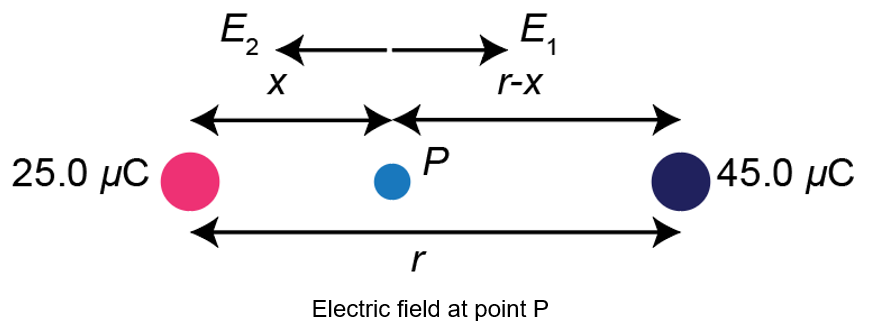Let the electric field be zero at point x from the \(25.0{\rm{ }}\mu C\). The electric field at x is represented as,

Here,\({E_1}\)is the electric field due to the charge\(25.0{\rm{ \mu C}}\),\({E_2}\)is the electric field due to the charge\(45.0{\rm{ \mu C}}\), and\(r\)is the distance between\(25.0{\rm{ \mu C}}\)and\(45.0{\rm{ \mu C}}\).
The electric field due to the charge\(25.0{\rm{ \mu C}}\)is,
\({E_1} = \frac{{K\left( {25.0{\rm{ }}\mu {\rm{C}}} \right)}}{{{x^2}}}\)
The electric field due to the charge\(45.0{\rm{ \mu C}}\)is,
\({E_2} = \frac{{K\left( {45.0{\rm{ }}\mu {\rm{C}}} \right)}}{{{{\left( {r - x} \right)}^2}}}\)
The net electric field at point P is,
\(\begin{array}{c}E = {E_1} - {E_2}\\ = \frac{{K\left( {25.0{\rm{ }}\mu {\rm{C}}} \right)}}{{{x^2}}} - \frac{{K\left( {45.0{\rm{ }}\mu {\rm{C}}} \right)}}{{{{\left( {r - x} \right)}^2}}}\end{array}\)
Since, the net electric field at point P is zero i.e.,\(E = 0\). Therefore,
\(\begin{array}{c}0 = \frac{{K\left( {25.0{\rm{ \mu C}}} \right)}}{{{x^2}}} - \frac{{K\left( {45.0{\rm{ \mu C}}} \right)}}{{{{\left( {r - x} \right)}^2}}}\\\frac{{K\left( {25.0{\rm{ \mu C}}} \right)}}{{{x^2}}} = \frac{{K\left( {45.0{\rm{ \mu C}}} \right)}}{{{{\left( {r - x} \right)}^2}}}\\{\left( {\frac{{r - x}}{x}} \right)^2} = \frac{{45}}{{25}}\end{array}\)
Therefore, the expression for\(x\)(distance where electric field is zero from\(25.0{\rm{ \mu C}}\)) is,
\(\begin{array}{c}\frac{r}{x} - 1 = \sqrt {\frac{{45}}{{25}}} \\\frac{r}{x} = \sqrt {\frac{{45}}{{25}}} + 1\\x = \frac{r}{{\sqrt {\frac{{45}}{{25}}} + 1}}\end{array}\)
Substitute\(0.500{\rm{ m}}\)for\(r\),
\(\begin{array}{c}x = \frac{{0.500{\rm{ m}}}}{{\sqrt {\frac{{45}}{{25}}} + 1}}\\ = 0.214{\rm{ m}}\end{array}\)
Hence, the electric field will be zero at \(0.214{\rm{ m}}\) from the \(25.0{\rm{ \mu C}}\).





